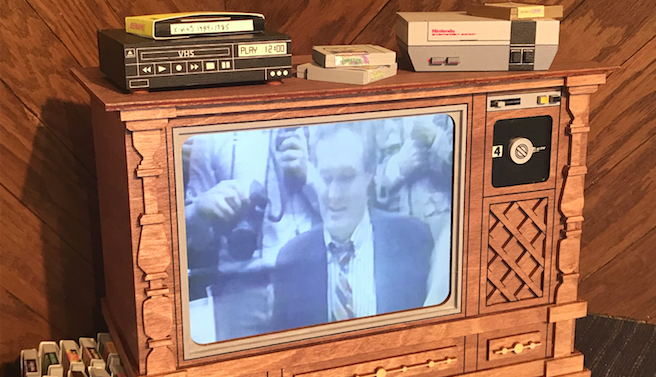While many artists look to the world around them for creative inspiration—whether physical beauty, political strife or natural landscapes—others prefer to uproot our shared reality altogether by establishing their own unique realms with distinct characters and rules. On view at the Oconee Cultural Arts Foundation, “Ultra Normal: Tales From Nowhere” melds the idiosyncratic worlds of Justin Barker, Gunnar Tarsa and Jennifer Torres. Invited by Gallery and Education Director Abby Kosberg to participate in the annual Director’s Choice Exhibition, each of the artists experiments with scale, narrative and form to challenge the viewer’s concept of normalcy.
Gracing the cover of Flagpole this week, Barker’s “Basement, 1995” is a three-dimensional, miniature replica of his parents’ basement that causes sensations of spatial displacement, disorientation of time and nostalgia. Each element—the 1978 Zenith Chromacolor II television, scattered Nintendo cartridges, patterned wallpaper and wood paneling—was sized down, digitally designed, laser cut and screen printed in a process echoing the mass production of an accelerating global economy.
“That basement seemed to encapsulate time, with its random assortment of outdated furniture and technology,” says Barker. “The video is found footage from a thrift store. I have no idea who those people are. But it adds an element of voyeurism to the idea of the viewer already being in someone else’s domestic space.”
Barker invites visitors to observe even more of his rural Midwestern upbringing through “House, 1984,” a small-scale toy house modeled after his family’s home, accompanied by a rack of packaged build-your-own versions staged as souvenirs. The miniature scene immediately challenges viewers to pick a size—are you a giant hovering above, like in “Stopover in a Quiet Town” from “The Twilight Zone,” or are you ready to leave your body behind in order to let your imagination navigate through the building’s hidden interiors?
“The toy aesthetic immediately disarms the viewer. It cuts through to an age where the viewer has less baggage, and sets the stage for a more pointed statement,” says Barker. “In addition, the miniature demands closer inspection. It not only invites the viewer to observe the interior, but allows for a godlike ownership over the space. This strange collision of ownership then happens between my subtext and the viewer’s desire to at once consume and own the miniature space.”
Much of Tarsa’s body of work illustrates The Boy Who Sees Yellow, a character from a parallel world beyond the darkest reaches of space who has come into existence through some inexplicable, primordial spark in the cosmos. Resembling a young human boy in physical form, he’s depicted as a black-lined, white-bodied figure with a beating red heart and glowing yellow eyes. Finding himself possibly alone in a vast universe, he manifests his visions into physical form and creates his own new reality.
Tarsa employs an automatic mark-making approach to creating artwork, allowing his stream of consciousness to materialize as spontaneous doodles, scribbles and illustrations. He calls these internal ideas “Mind Matter,” and sees himself as a conduit for channeling The Boy Who Sees Yellow’s Mind Matter into two-dimensional renderings that offer a glimpse into this other world. Stylistically resembling the bold, busy lines of Keith Haring, Tarsa’s work is full of optimism, love and exploration.
Similarly giving life to creatures attempting to spread peace, acceptance and love, Torres’ body of work, “Weirdo Children of the Misfit Army,” is comprised of brightly colored alien, but approachable, oddballs. Made in reaction to the current political climate, she views her sculptures as representative of the social outcasts and disenfranchised individuals who are rising in numbers. Though lacking facial features, their peculiar, slightly upturned postures and gentle demeanors give them a puppy-dog playfulness. Creatively displayed among irregularly stacked and scattered gallery podiums, they feel both mischievous and confident in taking over the space.

“Make Your Belly Full (Ballad of Losing an Appetite)” by Karen Campbell
On view in OCAF’s main gallery, the 24th annual national juried art exhibition “SouthWorks” offers over 50 pieces submitted from across the country. This year’s guest juror was Chad Alligood, an independent curator and art historian of modern and contemporary American art who also received an MFA from UGA’s Lamar Dodd School of Art. Featuring paintings, sculptures, photography and fabrics, the show finds local favorites like Jim Norton, Cheryl Washburn and Sara Parker alongside interesting new faces from afar, like Karen Campbell, Everett Hoffman and Brian Paulsen.
Both “SouthWorks” and “Ultra Normal” will remain on view through Friday, May 24.
Like what you just read? Support Flagpole by making a donation today. Every dollar you give helps fund our ongoing mission to provide Athens with quality, independent journalism.










